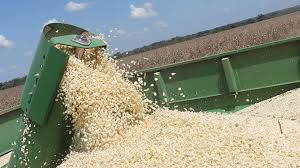Hwange farmers go for small grains
Share

Farmers in Hwange in Matebeleland North have heeded government’s advice to grow small grains in this arid part of the country to ensure food self-sufficiency.
Hwange falls in Natural Region 5 which received below normal to little rainfall even in good years. This makes growing of crops such as maize difficult leading to most households facing perennial food shortages.
But government has over the past few years encouraged small holder farmers to instead concentrate of growing small grains which are drought resistant.
The farmers will then exchange their produce with maize and Grain Marketing Board depots.
This year, the country is expected to experience the El Nino effect meaning that it will not receive good rains with the direr regions being susceptible to drought.
Farmers in St Mary’s and Dete were busy planting sorghum, millet and maize with the little rains they had received in December and early January. Those who took advantage of the December rains were also busy weeding their crops, most of which were at three and four leaf stage.
In an interview with Indonsakusa people from various villages in Hwange were hopeful that the current weather spell will continue as they went about their chores.
Sonela Mwakasikele from Gamba in St Mary's area said: “I’m still hopeful that the rain will continue, and I have great faith in it. I have planted sorghum, millet, and a small amount of maize. The crops have grown to knee height, with only a few exceeding that.”
Mwakasikele attributed this difference in crop maturity to the fact that sorghum and millet thrive in sandy soils, which are prevalent in their area, while maize typically did not perform as well in comparison.
“I added pumpkins, cucumbers, and cowpeas to the crops that thrive in this region. In my area, it is unusual for people to have enough food that last them a year. Most complete their food stocks between September and November before buying to complement,” added Mwakasikele.
Another villager from Sianyanga in Dete, John Tshuma said it was now too late to plant maize as the planting season had already passed.
I planted short season crops this year because the time was limited, and short season crops are the most suitable. Currently, most crops are above knee height due to the popularity of the pfumvudza/intwasa planting method," he explained.
Sorghum, millet, and cowpeas have emerged as the favourites in this innovative agricultural approach.
These small grains are drought tolerant, require less water while showcasing robust growth even in the face of extreme weather conditions. By diversifying the crops cultivated in Region 5, farmers are now empowered with a more sustainable and resilient farming system.
Training programmes, financial incentives, and the provision of high-quality seeds have been implemented to ensure the success of this transition. As a result more farmers are embracing small grains, seeing them as a pathway to sustaining their food requirements.
Farmers who have adopted small grains have reported increased yields and improved resilience to climatic variations. Additionally, this shift has the potential to enhance food security for the region, reducing dependence on imports and strengthening local economies.






